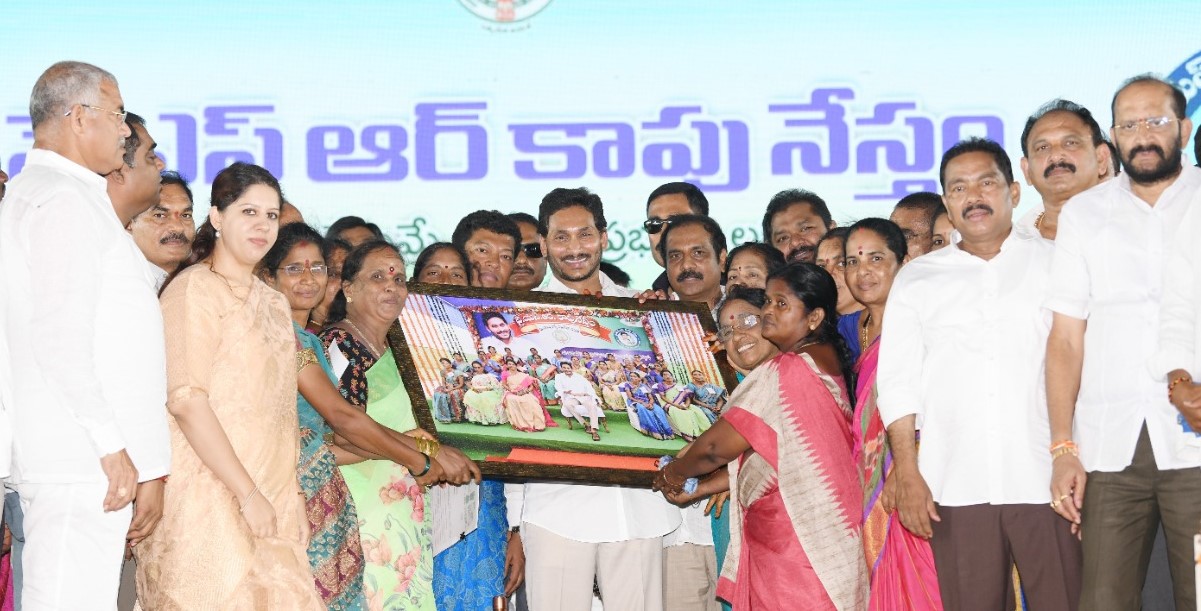Kapus, after OBCs, are a numerically strong community in the state comprising about 15 percent of the total population.

Jagan Mohan Reddy during the Kapu Nestham event. (AndhraPradeshCM/Twitter)
The Union government has once again put the onus of providing reservation to Kapus on Andhra Pradesh Chief Minister YS Jagan Mohan Reddy, three years after he had scrapped the five percent quota granted to the numerically strong community.
The Centre clarified that the state is empowered to provide reservations to Socially and Educationally Backward Classes (SEBC). It could be done by maintaining a separate list as mandated by Article 342A (3) of the Constitution.
Kapus constitute more than 15 percent of the state’s population. However, including them in the Other Backward Classes (OBC) category would catapult the overall reservation quota in the state to 55 percent.
The Supreme Court had earlier stated that any quota exceeding the 50 percent threshold is unconstitutional.
In 1992, a nine-judge bench of the Supreme Court capped the reservation quota at 50 percent while giving its ruling in the Indra Sawhney vs Union of India case (also known as the Mandal verdict).
The court observed that if the quota went beyond the 50 percent mark, it would militate against the Constitution-guaranteed equal access.
However, the court upheld the validity of the 105th amendment to the Constitution that included a 10 percent reservation quota for the Economically Weaker Sections (EWS). The addition took the quota past the 50 percent ceiling.
Reservation for Kapus in educational institutions and government jobs has been a contentious issue in Andhra Pradesh for a long time. Kapus have been demanding that they be included in the OBC list.
“The Supreme Court, in its Indra Sawhney case judgment, observed that the reservation may cross/exceed the 50 percent mark when there is a reasonable case for exceeding the limit,” Dasari Ramu, state convener of Kapu, Telaga, Balija Aikya Karyacharana Vedika, told South First.
“The court also stated that the reason should be substantiated with relevant data or study,” he added. Telaga and Balija are sub-castes of the Kapus.
In fact, he added that Kapus were covered under reservation quota in the past and they were only demanding that it be restored.
“Moreover, the previous TDP government under N Chandrababu Naidu had accorded reservation to Kapus based on the Justice KL Manjunatha Committee’s report,” Ramu justified.
However, Backward Classes are vociferously opposing any move to bring Kapus under the reservation quota.
“Kapus argue that they are only asking for what they once had. But they don’t say why the reservation benefit was taken away from them,” Guduru Venkateswara Rao, president of All India BC Praja Welfare Association, told South First.
“It was because they are economically, socially, and politically influential. You take any field — be it movies, educational institutions, businesses, or politics — Kapus are on a par with other influential forward caste communities like Reddys, Kammas, Kshatriyas, and Vysyas,” he explained.
“Why do they need reservations? Our children stand to lose if they are included in the (OBC) list,” Rao further said.
In July 2018, addressing a public meeting at Jaggampeta in the East Godavari district, YS Jagan Mohan Reddy said he cannot assure reservation for Kapus if voted to power, since granting quota to communities was not in the purview of the state government. He became the chief minister on 30 May, 2019.
He then added that the issue rests with the Centre. There were instances in which reservations given by states were struck down, Jagan said in the Kapu heartland.
The Madras Presidency, then under the British, had recognised Kapus as a backward caste in 1915. Andhra was carved out of the composite Madras state on 1 October, 1953. The new state adopted the backward classes list that existed in Madras. Kapus were on the list.
On 1 November, 1956, the Telugu-speaking areas in Hyderabad (Telangana) were added to Andhra, and the state came to be known as Andhra Pradesh. The expanded state ended up having two backward class lists after it adopted the list of Telangana as well.
The same year, Kapus were excluded from the list. Successive governments tried to recognise Kapus as a backward class, albeit in vain. Though a government order was issued to declare the community as backward class, the high court struck down the order on technical grounds.
As years passed by, the demand of the Kapus — mostly farmers owning huge tracts of land, especially in the Godavari delta — for reservation grew louder.
Though Kapus are a dominant caste — numerically, socially, and culturally — it has never had a chief minister.
Tollywood matinee idol Chiranjeevi, a Kapu, once attempted to helm Andhra Pradesh. He launched a political party, the Praja Rajyam, which failed to curry much favour with the people, and the outfit gradually faded away.
Chiranjeevi’s brother and actor Pawan Kalyan is now active in politics with his Jana Sena Party. And the TDP’s moves to tie up with his party is seen as an attempt to consolidate the Kapu vote in its favour.
Due to their numerical strength, political formations have always accorded much importance to Kapus. For instance, YSRCP has at least 26 MLAs and three MPs from the Kapu community. The party has 151 MLAs and 22 MPs.
The Jagan Cabinet has four ministers, including one deputy chief minister, from the Kapu community.
The Cabinet comprises 11 ministers from backward classes, five from scheduled castes, one ST, and eight from other castes, including the Kapu ministers. The remaining four are from the Reddy community.
The Kapu reservation issue has always become a talking point close to elections. TDP’s N Chandrababu Naidu assured reservation to the community before the 2014 elections. Though he rode to power, Naidu sat on the promise and constituted the KL Manjunatha Commission to look into the reservation issue only in February 2016.
It is believed that the support of Kapus helped TDP in winning the 2014 elections by a narrow margin of 2.06 percentage point vote share. As Naidu delayed granting quota to Kapus, community leader Mudragadda Padmanabham called for a protest on 31 January, 2016, at Tuni in the East Godavari district.
The rally turned violent, and the protesters set fire to the Ratnachal Express and ransacked the Tuni railway station. The Kapus displayed their strength, which the government was forced to recognise.
After the protest, the Manjunatha Commission was set up. While the recommendations of the commission were kept under wraps, the Naidu government passed a law to provide Kapus five percent reservation by including them in the OBC list under Category F.

YSRCP general secretary V Vijaysai Reddy has a word with AP Assembly speaker Tammineni Seetaram, minister Botsa Satyanarayana at the party BC meeting held recently. (Supplied)
Both Kapus and backward classes hold the key to power in the state. They together form around 52 percent of the total electorate, and in the 2014 polls, the TDP rode on their support to power by defeating the YSRCP.
While the backward classes have always patronised the TDP, Kapus’ support changed the tide in favour of Naidu in 2014. While Kapus constitute 15.2 percent of Andhra Pradesh’s overall population, the backward classes which include 143 different communities, account for 37 percent.
The 2019 Assembly election saw a major shift in backward classes’ political loyalty, which helped the YSRCP to trounce the TDP. The YSRCP had at least 41 candidates from the backward classes in that election.
Putting the ball in Jagan’s court, Union Minister of State for Social Justice and Empowerment Pratima Bhoumik told the Rajya Sabha on 21 December, 2022, that the central government’s permission is not required to extend backward classes reservation to any caste in the states.
She was responding to BJP MP GVL Narasimha Rao’s question on extending the benefits of reservation to the Kapu community.
The Union minister further stated that there are separate central and state lists for backward classes ever since the Centre provided reservations to other backward classes in 1993.
On the due procedure to be followed by the state government to give reservations to the Kapu community, Bhoumik said that the state government is empowered to provide reservations to Socially and Educationally Backward Classes (SEBC).
The state could prepare and maintain a separate list of SEBCs as per the provisions of the 342A (3) inserted vide the Constitution’s 105th Amendment Act, 2021.
“Both the YSRCP and TDP have cheated Kapus in Andhra Pradesh by repeatedly misleading them by saying that the state government does not have the authority to give reservations and blaming the Central government, which has nothing to do with the issue,” Narasimha Rao said.
“The central government’s reply in Parliament has exposed the lies of the YSRCP and TDP,” he added.
Under fire for not meeting the 2014 poll promise of providing reservations to Kapus, the N Chandrababu Naidu-led TDP government passed the Andhra Pradesh Kapu (Reservation of Seats in Educational Institutions and of Appointments or Posts in the Services under the State) Bill, in 2017.
After passing the bill in the state legislature, the state forwarded it to the Ministry of Home Affairs for the President’s assent.
The Naidu government wanted to introduce a new category, ‘F’, in the state OBC’s list, setting aside a five percent quota for Kapus.
The bill was circulated to the nodal ministries/departments for comments. The comments from the Ministry of Social Justice and Empowerment and the Department of Personnel and Training were forwarded to the state government for further comments/clarifications.
Meanwhile, the Naidu government provided five percent reservation to the Kapu Community by dividing the Union government’s 10 percent reservation to the Economically Weaker Sections (EWS) among the open category castes.
However, the Jagan government reversed the Naidu government’s decision, stating that it was not legally tenable. The chief minister, in July 2019, said that the 10 percent EWS reservation was exclusively for the poorest among forward castes.
Providing a five percent reservation quota to Kapus will increase the overall reservations in the state to 55 percent, surpassing the 50 percent threshold.
In 2018, the Supreme Court declared unconstitutional a Maharashtra law that provided reservation benefits to the Maratha community, taking the quota limit above 50 percent.
In Andhra Pradesh, 145 castes and sub-castes of OBCs are categorised into five: A, B, C, D and E, and are provided 29 percent reservations.
While Category A enjoyed a seven percent quota in the reservation, Category B has 10 percent, C one percent, D seven percent, and E four percent.
Scheduled castes are given 15 percent and Scheduled Tribes (ST), six.

Apr 19, 2024

Apr 19, 2024

Apr 18, 2024

Apr 18, 2024

Apr 18, 2024